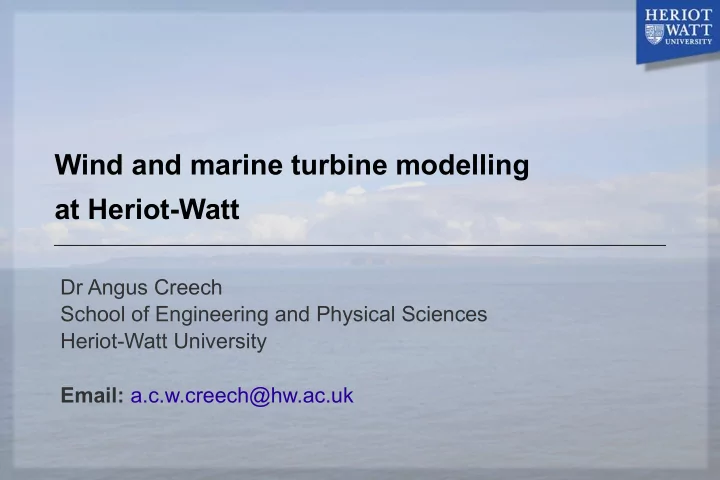

Wind and marine turbine modelling at Heriot-Watt Dr Angus Creech School of Engineering and Physical Sciences Heriot-Watt University Email: a.c.w.creech@hw.ac.uk
Introduction :: motivation and goals • Cost/benefit analysis: energy yield estimation for layout optimisation • Downstream effects: – environmental impact assessment – farm developments – wake modelling over large distances • Second-by-second performance data for each turbine
Introduction :: farm configuration • Wind farm utilisation is on average 30% of rated power • Graph shows % efficiency increase v. annual savings for farm • Accurate farm modelling allows for better planning • And for marine turbine farms?
Theory :: model overview • Cylindrical volume in which body forces act – no boundary conditions • Uses hybridised blade-element theory
Theory :: model overview (2) Turbine module uses state-of-the-art computational fluid dynamics (CFD) software to model turbulent flow. • Turbulence is modelled by large-eddy simulation • Bathymetry and bottom drag can be added • Free surfaces are possible • Large simulations – scalable to thousands of cores
Theory :: parameterisation To parameterise the turbine, need: • Blade geometry and weight • Lift/drag coefficient graphs distribution
Theory :: turbulence Generated at end of turbine volume, divided into three sections: 1. Tip 2. Inner section 3. Hub
Marine :: water channel Marine Current Turbine Ltd – Seaflow (300 kW) 200 m 40 m 1000 m
Marine :: velocity profile Turbulence intensity slice calculated over 45 minutes
Marine :: videos • Bottom drag vertical slice (solid slice here / contours here) • Bottom drag case horizontal slice (click here)
Validation work
Validation with wind turbines Joint project with energy company to validate model against real data. • Site selected with turbine in-situ • LIDAR site measurements provided for wake comparison • Ordinance Survey (OS) data used for terrain modelling • Ground features (trees, grass etc.) added as boundary conditions • Realistic wind profiles as boundary conditions
Model overview • Large simulation domain – 6km x 6km x 750m • Southwesterly wind at 8 m/s peak (~6 m/s at hub height) • 950kW turbine at centre of domain, 50m hub height
Specification :: ground features • OS map data provides data on locations of trees, grass, water, etc. • Graymap overlay converted to drag coefficients, zero-mean displacements and roughness lengths.
Specification :: land relief • OS contour data at 10m intervals • Used to generate height grid • Finite-element mesh fitted to height grid • Bottom surface locked to preserve topography
Specification :: boundary conditions • Log wind speed profile set at boundaries • Specified wind direction • In future will use Synthetic Eddy Method with LIDAR turbulence measurements – fully turbulent boundary conditions
Specification :: turbine parameters • 950 kW turbine: 54.5m diameter, 50m hub- height • Lift/drag characteristics taken from NACA data • Blade geometry (chord length, blade twist) and performance data taken from manufacturer's technical manual
Results :: turbine performance
Results :: wake comparison LIDAR contours Model contours Wake profiles
Results :: wake comparison (2) • Wake deficit comparison with other sites (Creech et al, 2010)
Results :: horizontal slice at t=60s
Results :: horizontal slice at t=300s
Results :: horizontal slice at t=300s
Results :: vertical slice at t=60s
Results :: vertical slice at t=300s
Results :: vertical slice at t=900s
Results :: mesh view at t=300s
Videos • Vertical slice: – whole model, looking NW (click here) – zoomed view (click here) – contour plot (click here) • Horizontal slice – Zoomed contour plot (click here)
Model summary Model can simulate: ● Wind or tidal flow over large areas with land relief or seafloor ● Response of multiple turbines to wind or marine currents and the up/downstream wake effects ● Transport of 'tracer' properties of fluid Model provides: ● Per-timestep 3D data set for velocity, pressure, tracer concentrations ● Per-timestep performance data for each turbine ● Time-averaged velocity plots and turbulence plots
Future plans • Modelling of performance and wakes in small farm configurations • Validation of marine/wind farm modelling with wake and performance measurments • Feeding into a virtual grid? Modelling actual electrical supply over typical periods – additional expertise required • Utilisation as a planning tool: small-scale test cases required
End
Recommend
More recommend